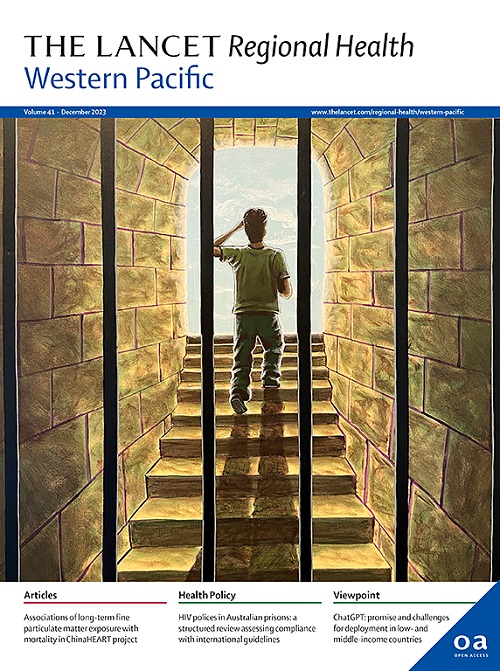1990-2021年中国及其各省空气污染造成的2型糖尿病负担:2021年全球疾病负担研究分析
IF 7.6
1区 医学
Q1 HEALTH CARE SCIENCES & SERVICES
引用次数: 0
摘要
背景中国尚未完全了解空气污染(包括环境污染和家庭污染)导致的 2 型糖尿病负担的时间趋势和地域差异。方法我们评估了中国 33 个省、自治区、直辖市和特别行政区的空气污染暴露情况,重点关注两种常见的空气污染形式:环境颗粒物污染(定义为 PM2.5 的年网格浓度)和家庭空气污染(定义为使用固体烹饪燃料的家庭比例及其相应的 PM2.5 暴露)。我们采用了《2021 年全球疾病、伤害和风险因素负担研究》(GBD)中的方法,按年龄、性别、年份和省份估算了空气污染对 2 型糖尿病死亡人数和残疾调整生命年数的影响。研究结果 2021 年,全国约五分之一的 2 型糖尿病负担可归因于空气污染,按年龄标准化估算,每 10 万人中有 1.76 人死亡,110.79 人残疾调整生命年数减少,男性的比例更高。环境 PM2.5 造成了 16.89% 的死亡和 16.36% 的残疾调整寿命年数,而家庭空气污染造成了 3.24% 的死亡和 3.07% 的残疾调整寿命年数。从 1990 年到 2021 年,环境 PM2.5 污染导致的 2 型糖尿病死亡率上升了 264.23%,而家庭空气污染导致的 2 型糖尿病死亡率下降了 80.8%。2021 年,北京因环境 PM2.5 污染导致的残疾调整寿命年数人口可归因分数(PAFs)最高,为 19.63%,而西藏因家庭空气污染导致的残疾调整寿命年数人口可归因分数(PAFs)最高,为 13.72%。环境PM2.5导致的2型糖尿病年龄标准化残疾调整寿命率在各省之间差异很大,从天津的每10万人中有143.8人,到西藏的每10万人中有21.6人。需要采取紧急行动,加强空气污染控制,并制定适合本地的预防策略,以减轻与空气污染相关的2型糖尿病的负担。本文章由计算机程序翻译,如有差异,请以英文原文为准。
The burden of type 2 diabetes attributable to air pollution across China and its provinces, 1990–2021: an analysis for the Global Burden of Disease Study 2021
Background
Temporal trends and geographical disparities in type 2 diabetes burden attributable to air pollution, including ambient and household, are not fully understood within China. This study aims to estimate the burden of type 2 diabetes attributable to air pollution at national and provincial levels from 1990 to 2021.
Methods
We assessed air pollution exposure across 33 Chinese provinces, autonomous regions, municipalities, and special administrative regions, focusing on two common forms of air pollution: ambient particulate matter pollution (defined as the annual gridded concentration of PM2.5) and household air pollution (defined as the percentage of households using solid cooking fuels and their corresponding exposure to PM2.5). We employed the methods from the Global Burden of Diseases, Injuries, and Risk Factors Study (GBD) 2021 to estimate the attribution of air pollution on type 2 diabetes deaths and disability-adjusted life years (DALYs) by age, sex, year, and province.
Findings
In 2021, about a fifth of the national type 2 diabetes burden was attributable to air pollution, with an age-standardised estimate of 1.76 deaths and 110.79 DALYs per 100,000 population, higher in males. Ambient PM2.5 contributed to 16.89% of deaths and 16.36% of DALYs, while household air pollution contributed to 3.24% of deaths and 3.07% of DALYs. From 1990 to 2021, type 2 diabetes mortality rates due to ambient PM2.5 pollution increased by 264.23%, whereas those from household air pollution decreased by 80.8%. In 2021, Beijing had the highest population attributable fraction (PAFs) of DALYs due to ambient PM2.5 pollution at 19.63%, while Tibet had the highest PAFs for household air pollution at 13.72%. The age-standardised DALYs rates for type 2 diabetes due to ambient PM2.5 varied widely across provinces, from 143.8 per 100,000 people in Tianjin to 21.6 per 100,000 people in Tibet.
Interpretation
Air pollution, especially ambient PM2.5, is a significant risk factor for type 2 diabetes in China. Urgent action is needed to enhance air pollution control and develop locally adapted preventive strategies to reduce the burden of air pollution-related type 2 diabetes.
Funding
Sanming Project of Medicine in Shenzhen (NO. SZSM202111001).
求助全文
通过发布文献求助,成功后即可免费获取论文全文。
去求助
来源期刊

The Lancet Regional Health: Western Pacific
Medicine-Pediatrics, Perinatology and Child Health
CiteScore
8.80
自引率
2.80%
发文量
305
审稿时长
11 weeks
期刊介绍:
The Lancet Regional Health – Western Pacific, a gold open access journal, is an integral part of The Lancet's global initiative advocating for healthcare quality and access worldwide. It aims to advance clinical practice and health policy in the Western Pacific region, contributing to enhanced health outcomes. The journal publishes high-quality original research shedding light on clinical practice and health policy in the region. It also includes reviews, commentaries, and opinion pieces covering diverse regional health topics, such as infectious diseases, non-communicable diseases, child and adolescent health, maternal and reproductive health, aging health, mental health, the health workforce and systems, and health policy.
 求助内容:
求助内容: 应助结果提醒方式:
应助结果提醒方式:


